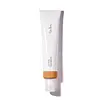What's inside
What's inside
 Key Ingredients
Key Ingredients

 Benefits
Benefits

 Concerns
Concerns

 Ingredients Side-by-side
Ingredients Side-by-side

Aloe Barbadensis Leaf Juice
Skin ConditioningCoconut Alkanes
EmollientCaprylyl Methicone
Skin ConditioningPolyglyceryl-6 Polyricinoleate
EmulsifyingCetearyl Isononanoate
EmollientPolyglyceryl-2 Isostearate
EmulsifyingBoron Nitride
AbsorbentDimethicone
EmollientDisteardimonium Hectorite
StabilisingNiacinamide
SmoothingOryza Sativa Hull Powder
AbrasiveGluconolactone
Skin ConditioningSodium Chloride
MaskingIsopentyldiol
HumectantGlycerin
HumectantCoco-Caprylate/Caprate
EmollientAllantoin
Skin ConditioningSodium Benzoate
MaskingCaprylic/Capric Triglyceride
MaskingSimmondsia Chinensis Seed Oil
EmollientSclerocarya Birrea Seed Oil
HumectantSqualane
EmollientTocopherol
AntioxidantPentylene Glycol
Skin ConditioningTriethoxycaprylylsilane
Pistacia Lentiscus Gum
MaskingHydrogenated Lecithin
EmulsifyingCalcium Gluconate
HumectantEthylhexylglycerin
Skin ConditioningJasminum Officinale Flower/Leaf Extract
MaskingPhenethyl Alcohol
MaskingBisabolol
MaskingCI 77891
Cosmetic ColorantCI 77491
Cosmetic ColorantCI 77492
Cosmetic ColorantCI 77499
Cosmetic ColorantAloe Barbadensis Leaf Juice, Coconut Alkanes, Caprylyl Methicone, Polyglyceryl-6 Polyricinoleate, Cetearyl Isononanoate, Polyglyceryl-2 Isostearate, Boron Nitride, Dimethicone, Disteardimonium Hectorite, Niacinamide, Oryza Sativa Hull Powder, Gluconolactone, Sodium Chloride, Isopentyldiol, Glycerin, Coco-Caprylate/Caprate, Allantoin, Sodium Benzoate, Caprylic/Capric Triglyceride, Simmondsia Chinensis Seed Oil, Sclerocarya Birrea Seed Oil, Squalane, Tocopherol, Pentylene Glycol, Triethoxycaprylylsilane, Pistacia Lentiscus Gum, Hydrogenated Lecithin, Calcium Gluconate, Ethylhexylglycerin, Jasminum Officinale Flower/Leaf Extract, Phenethyl Alcohol, Bisabolol, CI 77891, CI 77491, CI 77492, CI 77499
Water
Skin ConditioningCoco-Caprylate/Caprate
EmollientGlycerin
HumectantPolyglyceryl-6 Polyricinoleate
EmulsifyingAvena Sativa Kernel Extract
AbrasivePrunus Persica Fruit Extract
AbrasiveTocopheryl Acetate
AntioxidantBiosaccharide Gum-1
HumectantSodium Anisate
AntimicrobialSodium Levulinate
Skin ConditioningMagnesium Sulfate
Sodium Salicylate
PreservativeEthylhexylglycerin
Skin ConditioningCitric Acid
BufferingGlyceryl Caprylate
EmollientPolyhydroxystearic Acid
EmulsifyingPotassium Sorbate
PreservativeCI 77491
Cosmetic ColorantCI 77492
Cosmetic ColorantCI 77499
Cosmetic ColorantCI 77891
Cosmetic ColorantWater, Coco-Caprylate/Caprate, Glycerin, Polyglyceryl-6 Polyricinoleate, Avena Sativa Kernel Extract, Prunus Persica Fruit Extract, Tocopheryl Acetate, Biosaccharide Gum-1, Sodium Anisate, Sodium Levulinate, Magnesium Sulfate, Sodium Salicylate, Ethylhexylglycerin, Citric Acid, Glyceryl Caprylate, Polyhydroxystearic Acid, Potassium Sorbate, CI 77491, CI 77492, CI 77499, CI 77891
 Reviews
Reviews

Ingredients Explained
These ingredients are found in both products.
Ingredients higher up in an ingredient list are typically present in a larger amount.
Ci 77491 is also hydrated iron III oxide. It's sole purpose is to give a red/pink hue to products.
Iron III oxides are classified as inorganic chemicals for coloring.
Synthetically created Ci 77491 is considered safer than those naturally found. This is because the synthetically created version may contain less impurities. Iron oxides are generally non-toxic and non-allergenic.
Learn more about CI 77491Ci 77492 is also hydrated iron III oxide. It's sole purpose is to give a yellow hue to products.
Iron III oxides are classified as inorganic chemicals for coloring.
Synthetically created Ci 77492 is considered safer than those naturally found. This is because the synthetically created version may contain less impurities. Iron oxides are generally non-toxic and non-allergenic.
Learn more about CI 77492Ci 77499 is also hydrated iron III oxide. It is created from mixing red and black iron oxides. This helps give shades of darkness to a product.
Iron III oxides are classified as inorganic chemicals for coloring.
Ci 77891 is a white pigment from Titanium dioxide. It is naturally found in minerals such as rutile and ilmenite.
It's main function is to add a white color to cosmetics. It can also be mixed with other colors to create different shades.
Ci 77891 is commonly found in sunscreens due to its ability to block UV rays.
Learn more about CI 77891Coco-Caprylate/Caprate is created from fatty coconut alcohol, caprylic acid, and capric acid.
It is a lightweight emollient. Emollients create a thin barrier on the skin to trap moisture in. This helps keep your skin hydrated and soft.
Once applied, Coco-Caprylate/Caprate is absorbed quickly and leaves a silky feel.
Coco-Caprylate/Caprate may not be fungal acne safe.
Learn more about Coco-Caprylate/CaprateEthylhexylglycerin (we can't pronounce this either) is commonly used as a preservative and skin softener. It is derived from glyceryl.
You might see Ethylhexylglycerin often paired with other preservatives such as phenoxyethanol. Ethylhexylglycerin has been found to increase the effectiveness of these other preservatives.
Glycerin is already naturally found in your skin. It helps moisturize and protect your skin.
A study from 2016 found glycerin to be more effective as a humectant than AHAs and hyaluronic acid.
As a humectant, it helps the skin stay hydrated by pulling moisture to your skin. The low molecular weight of glycerin allows it to pull moisture into the deeper layers of your skin.
Hydrated skin improves your skin barrier; Your skin barrier helps protect against irritants and bacteria.
Glycerin has also been found to have antimicrobial and antiviral properties. Due to these properties, glycerin is often used in wound and burn treatments.
In cosmetics, glycerin is usually derived from plants such as soybean or palm. However, it can also be sourced from animals, such as tallow or animal fat.
This ingredient is organic, colorless, odorless, and non-toxic.
Glycerin is the name for this ingredient in American English. British English uses Glycerol/Glycerine.
Learn more about GlycerinPolyglyceryl-6 Polyricinoleate isn't fungal acne safe.